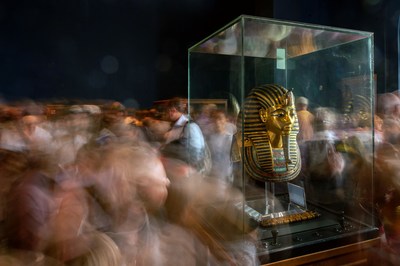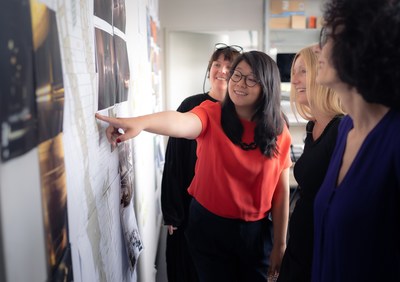TUTANKHAMUN GALLERY- GRAND EGYPTIAN MUSEUM: ATELIER BRÜCKNER DESIGNS PROJECT OF THE CENTURY
The legendary tomb of the child-king Tutankhamun was discovered in the Valley of the Kings exactly 100 years ago on 4 November 1922. In the Grand Egyptian Museum, the complete burial hoard is being exhibited for the first time. The exhibition design comes from ATELIER BRÜCKNER. "Truly a project of the century!", says CEO Shirin Brückner.

Tutankhamun, Golden Mask. The Egyptian Museum, Cairo, Egypt. Photography: ©Kenneth Garrett The mask will be the highlight and integrated part of the Tutankhamun Gallery, Grand Egyptian Museum, Giza.

Tutankhamun Gallery workshop, Atelier Brückner. Britta Nagel, Yijing Lu, Tanja Zöllner, Shirin Brückner. Photography: ©Christian Kroh
In December 2016, ATELIER BRÜCKNER was commissioned to design the Tutankhamun Gallery. It has 7,500 square metres of exhibition space, located on the second floor of a new building by heneghan peng architects. The world's largest museum of Egyptian art and culture with a total area of more than 90,000 square metres is set to open soon, close to the pyramids of Giza.
One of the main challenges is the expected number of visitors, at more than 15,000 per day. For them, ATELIER BRÜCKNER conceived a narrative visitor routing that, in spaces of huge dimensions, enables even small objects to command the attention that their outstanding importance demands.
Two parallel wings, each 180 metres long and up to 16 metres high, comprise the Tutankhamun Gallery. On show are 5,400 artefacts – including around 3,000 that have not been seen before. The greatest attraction is Tutankhamun's mask, one of the most valuable art objects worldwide.
The fantastic journey in the footsteps of Tutankhamun can be experienced as a coherent, spatially impressive narrative. The visitors accompany the myth-enshrouded king throughout his life step-by-step until his afterlife. Finally, they encounter Tutankhamun's grave in the form of a real-size abstract model onto which images of the discovery are projected. The interplay of architecture and narration, of materials, light, graphics, and interactive media creates an emotional experience.
ATELIER BRÜCKNER characterizes the Grand Egyptian Museum. Their work spans the main access axis, the atrium with an over eleven-meter-high statue of Ramses II and the expressive Grand Stairs – 180-metre-long backbone of the museum with large sculptures weighing several tons. The children's museum with 3,500 square metres of exhibition space on the first floor of the museum, is also designed by the German studio.
ATELIER BRÜCKNER designs exhibitions and architecture. Since 1997, it has been creating scenography that set standards in an international context. Designing scenographically means thinking in terms of space and content at the same time: creating experiential spaces that tell stories and convey history and knowledge.





































































































